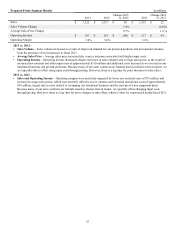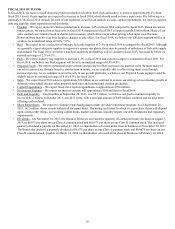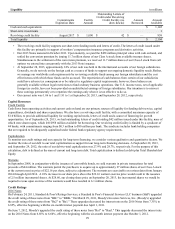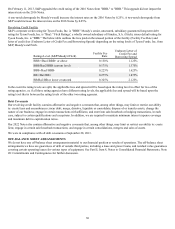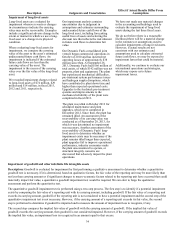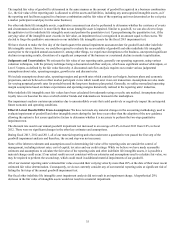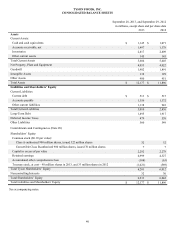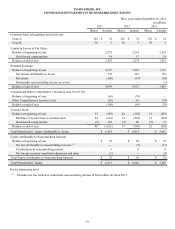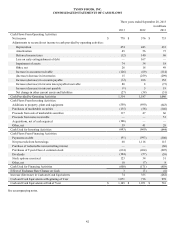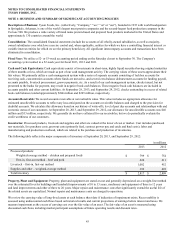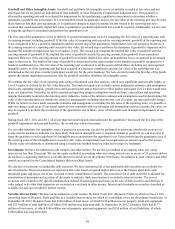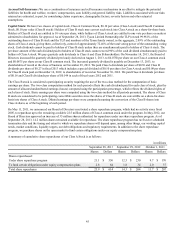Tyson Foods 2013 Annual Report Download - page 35
Download and view the complete annual report
Please find page 35 of the 2013 Tyson Foods annual report below. You can navigate through the pages in the report by either clicking on the pages listed below, or by using the keyword search tool below to find specific information within the annual report.35
The implied fair value of goodwill is determined in the same manner as the amount of goodwill recognized in a business combination
(i.e., the fair value of the reporting unit is allocated to all the assets and liabilities, including any unrecognized intangible assets, as if
the reporting unit had been acquired in a business combination and the fair value of the reporting unit was determined as the exit price
a market participant would pay for the same business).
For other indefinite life intangible assets, a qualitative assessment can also be performed to determine whether the existence of events
and circumstances indicates it is more likely than not an intangible asset is impaired. Similar to goodwill, we can also elect to forgo
the qualitative test for indefinite life intangible assets and perform the quantitative test. Upon performing the quantitative test, if the
carrying value of the intangible asset exceeds its fair value, an impairment loss is recognized in an amount equal to that excess. We
elected to forgo the qualitative assessments on our indefinite life intangible assets for the fiscal 2013 impairment test.
We have elected to make the first day of the fourth quarter the annual impairment assessment date for goodwill and other indefinite
life intangible assets. However, we could be required to evaluate the recoverability of goodwill and other indefinite life intangible
assets prior to the required annual assessment if, among other things, we experience disruptions to the business, unexpected significant
declines in operating results, divestiture of a significant component of the business or a sustained decline in market capitalization.
Judgments and Uncertainties: We estimate the fair value of our reporting units, generally our operating segments, using various
valuation techniques, with the primary technique being a discounted cash flow analysis, which uses significant unobservable inputs, or
Level 3 inputs, as defined by the fair value hierarchy. A discounted cash flow analysis requires us to make various judgmental
assumptions about sales, operating margins, growth rates and discount rates.
We include assumptions about sales, operating margins and growth rates which consider our budgets, business plans and economic
projections, and are believed to reflect market participant views which would exist in an exit transaction. Assumptions are also made
for varying perpetual growth rates for periods beyond the long-term business plan period. Generally, we utilize normalized operating
margin assumptions based on future expectations and operating margins historically realized in the reporting units' industries.
Other indefinite life intangible asset fair values have been calculated for trademarks using a royalty rate method. Assumptions about
royalty rates are based on the rates at which similar brands and trademarks are licensed in the marketplace.
Our impairment analysis contains uncertainties due to uncontrollable events that could positively or negatively impact the anticipated
future economic and operating conditions.
Effect if Actual Results Differ From Assumptions: We have not made any material changes in the accounting methodology used to
evaluate impairment of goodwill and other intangible assets during the last three years other than the adoption of the new guidance
allowing the option to first assess qualitative factors to determine whether it is necessary to perform the two-step quantitative
impairment test.
The discount rate used in our annual goodwill impairment test increased to an average of 8.4% in fiscal 2013 from 8.0% in fiscal
2012. There were no significant changes in the other key estimates and assumptions.
During fiscal 2013, 2012 and 2011, all of our material reporting units that underwent a quantitative test passed the first step of the
goodwill impairment analysis and therefore, the second step was not necessary.
Some of the inherent estimates and assumptions used in determining fair value of the reporting units are outside the control of
management, including interest rates, cost of capital, tax rates and our credit ratings. While we believe we have made reasonable
estimates and assumptions to calculate the fair value of the reporting units and other indefinite life intangible assets, it is possible a
material change could occur. If our actual results are not consistent with our estimates and assumptions used to calculate fair value, we
may be required to perform the second step, which could result in additional material impairments of our goodwill.
All of our material reporting units' estimated fair value exceeded their carrying value by more than 20% at the date of their most recent
estimated fair value determination. Consequently, we do not currently consider any of our material reporting units at significant risk of
failing the first step of the annual goodwill impairment test.
Our fiscal other indefinite life intangible asset impairment analysis did not result in an impairment charge. A hypothetical 20%
decrease in the fair value of intangible assets would not result in a material impairment.


